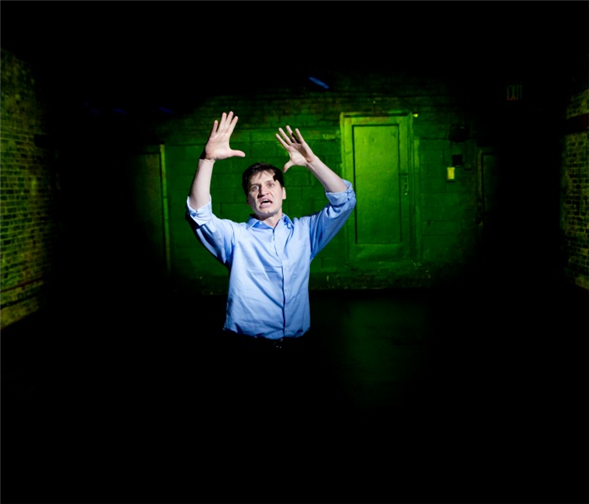Translate Page

A new solo shows offers a visceral, video-enhanced experience of the condition
---
Performer and playwright Gardiner Comfort has Tourette syndrome, a tic disorder that causes a range of involuntary, repetitive movements and vocalizations. When developing his autobiographical solo show about living with the condition, he knew he wanted to do more than just talk about it. So Comfort and his co-creator/director Kel Haney enlisted scenic and video designers Caite Hevner and Lianne Arnold to give audiences a visceral sense of how he experiences the world.
The resulting production, The Elephant in Every Room I Enter, is part of New York Theatre Workshop's inaugural season of Next Door at NYTW, a hub for artists who are producing their own work. Comfort and his collaborators have been working on the piece since 2015 when they did a brief run at La MaMa. "It's hard for someone to really understand just by listening to Gardiner describe it," Hevner explains. "We wanted to tell his story visually in order to take the audience on the journey with him."
And yet, at the outset, the set design for Elephant looks pretty bare-bones: just a scuffed brick wall and a lonesome microphone stand. Comfort comes on stage and starts talking. Then he hits the wall and the bricks ripple. "I spend a lot of time thinking about character," says Arnold. "With every project, I always ask myself: What is the character of the projection? Will the video be an extension of the protagonist, or a force working against him? Then I use that as the framework for the rest of the show."
{Image1}
The video in Elephant functions as more than just an extension of Comfort -- it's his visual language. "Gardiner has all of this extra energy -- that's what Tourette's is," Hevner says. "The piece therefore needs an extra step to express Gardiner's story. The visual energy that bursts out of his body really is him." To illustrate this, there are moments when lightning cracks and swallows the room, or saturated colors bleed across the wall. At one point pixelated flamingos even pass by. "A lot of the images come from Gardiner's childhood," Arnold says. "That's a time when you're learning about who you are and how to fit in."
Mining Comfort's youth for visuals makes sense since the National Institute of Neurological Disorders and Stroke notes that "most patients experience peak tic severity before the mid-teen years with improvement for the majority of patients in early adulthood." That hasn't been the case for Comfort though. During the 75-minute play, he recounts a life-changing week he spent at the Tourette Association of America's 2014 National Conference in Washington D.C. where he found himself surrounded by others -- mostly kids -- who also involuntarily coughed, shrieked, jerked, and spasmed. He sums it up succinctly: "For the first time in my life I felt normal."
---
Ned Moore is a dramaturg and theatre writer. Follow him at @nedmooretheatre. Follow TDF at @TDFNYC.
Top image: Gardiner Comfort in The Elephant in Every Room I Enter. Photos by Jenny Anderson.
TDF MEMBERS: Browse our discounted tickets for theatre, dance, and concerts.